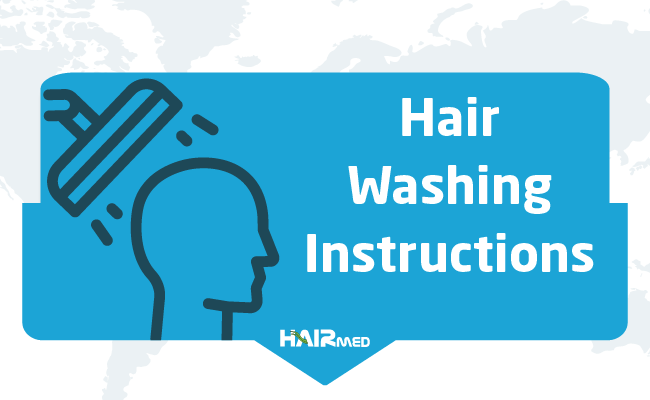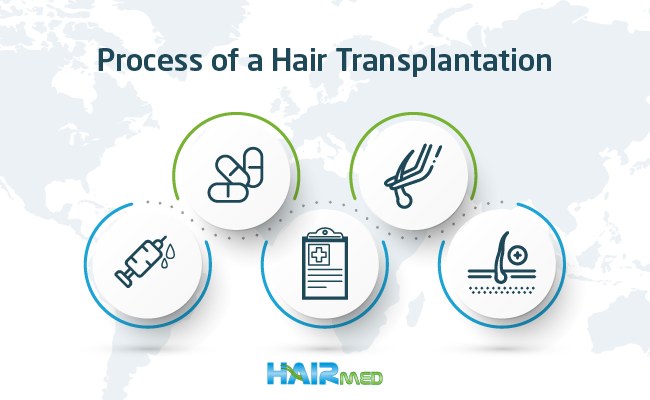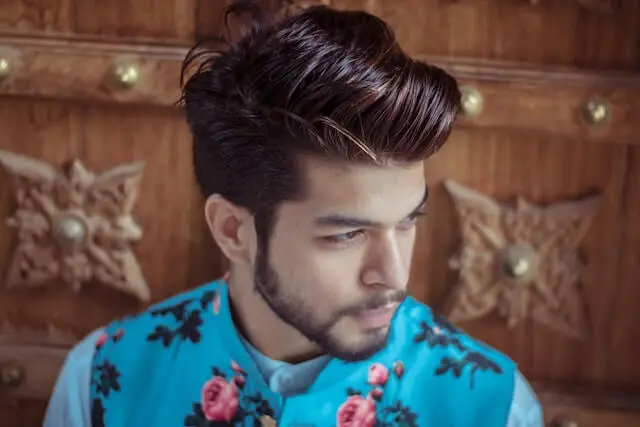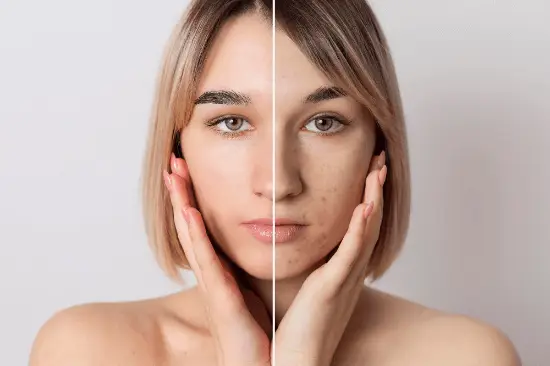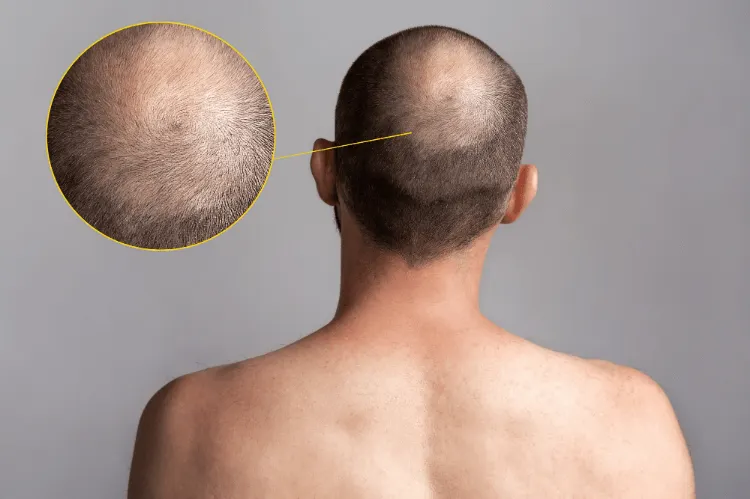For hair transplant healing, follow-up care should be followed as recommended.
1. Headgear
Immediately after the hair transplant you are socially acceptable again. So that no traces of the hair transplant are visible, you can wear a hat during the transitional period. We will give you a bandana headscarf that can be tied at the back of the neck. We recommend that you do not keep the bandana as headgear in closed rooms such as the office or at home, so that the wounds can absorb oxygen, the healing phase is accelerated and an increase in pressure in the head area is avoided. We only recommend wearing a loose bandana to protect you from strong sunlight when you leave the house, as described.
2. Movement sequences
After the operation and on the following day, you should rest as much as possible and not leave the house. Avoid strenuous activities or movements. This can lead to an increase in pressure in the blood vessels in the head area and to secondary bleeding in the first few days. You should also refrain from excessive coughing or screaming. Be careful not to hit your head. This happens quickly when getting in or out of a car and can cause bleeding. Avoid quick sideways movements, please do not lean forward or backward and try to keep your head as upright as possible. In this way you avoid bleeding in the transplantation and removal area, which can lead to problems with wound healing.
3. Sleeping position
For the first 10 days after this treatment you should only sleep on your back and if possible in a 20 to 30 degree elevated position. Try to stay in this position while you sleep. If possible, your sleeping position should be constantly checked by an attendant during the first night of sleep after the treatment. Use the neck pillow that you will receive from us so that the grafts and the transplant area come into contact with other materials as little as possible and do not become detached.
4. Clothing
Clothing should be chosen so that it is easy to take off and put on. This is especially true for the first few days after an FUE treatment. We recommend wearing clothing that closes with a zipper or buttons and does not need to be pulled over the head. Shirts are well suited as they do not have to be pulled over the head. For the first few days after the treatment, please ensure that there is no contact with the scalp or the transplanted area.
This is especially true for the first 10 days after treatment.
5. Proper Conduct
High blood pressure can reject the transplant. Sport, swimming, solarium and sauna should be avoided for a period of 4 weeks after the hair transplant to ensure uncomplicated healing. We
also recommend not having sexual intercourse for 2-3 days.
6. Alcohol & Smoking
To avoid complications after the operation, you should reduce alcohol and smoking before and after the operation (at least less than 5 cigs / day). Smoking and alcohol could delay the healing phase.
7. Swelling & Medication
Due to the local anesthetic and the liquid that is sprayed into your scalp during the treatment, swelling will occur in the forehead area after the transplant and will spread down the face to the eyebrows/eyelids or down the cheeks due to gravity. Usually on the third day after the operation, the swelling gradually decreases and finally disappears completely after a week at the latest. In individual cases it can take significantly longer up to 2-3 weeks. Once the swelling is above the neck area, it will no longer be visible. The liquid is gradually broken down by the lymph.
Tips on how to limit the swelling:
- Keep your head up as much as possible and do not lean forward.
- Regular cooling with a cool pack after the treatment reduces the swelling. To do this, only cool the forehead or eye area and never the transplant area. Store the Cool Pack in the fridge, not in the freezer.
- Drink plenty of fluids as this will flush the fluids used during the treatment out of your body as quickly as possible.
- Blow your nose as little as possible, as the pressure that this creates can cause significant swelling in the first few days after the FUE treatment.
After the local anesthetic wears off after the procedure, headaches and wound pain occasionally occur, but these quickly subside. All pain and discomfort can easily be assuaged with painkillers and antibiotics. Sensory disturbances and states of tension may occur in the donor area and in the transplanted area, but these will subside after a few weeks.
After the hair transplant, please take the medicines that you will receive from us as follows (until the packs are ready):
after eating,
- Cipracid (anti-inflammatory antibiotic) 2 times a day.
- On the day after the procedure, Fito will be applied to the donor area 2 times a day (morning and evening).
- You can take one Dexofen pain reliever after the procedure and if you have pain afterwards.
8. Hair wash
Blood crusts form in the transplanted areas after the operation. The crusts on the grafts must not be removed. If you wash your hair regularly, these blood crusts fall off by themselves after 10 days.
The washing procedure should be carried out as follows:
The first hair care and hair washing is on the 2nd day after the operation
Apply lotion and wash off
- Please gently apply the prescribed lotion to the transplant area using gentle pressure (patting with clean fingertips, NOT rubbing). This softens the crusts in the planting area. You can apply the lotion normally to the donor area and massage in in circular movements.
- Leave the lotion on for about 30-45 minutes, then you can gently dab it off with lukewarm dabs. At the dispensing area, you can use normal washing movements to rinse off the lotion.
Apply shampoo and wash off
- On the donor area you can apply the suggested shampoo (Sebamed) normally and wash with normal washing movements. But wash the transplant area carefully. Please only dab, NOT rub and rub.
- Wash your hair with plenty of lukewarm water. Please run slowly.
Dry
- Do not use a hair dryer. Dry your hair with a towel without rubbing. Just press and dab.
- Substances such as hairspray, gel and the like should no longer be used afterwards. It is important that as much of the crusts as possible is removed after about 10-15 days for a good healing process. After 10-15 days, after washing and rinsing has eliminated crusts, you can wash your hair normally with your own shampoo.
9. Hair growth after hair transplant
Within the first 2-6 weeks after hair transplantation, hair remaining in the transplanted roots will initially fall out again. This is the body’s natural response to the transplant and is perfectly normal. The reason for this is a temporary lack of oxygen, which the transplanted hair roots suffer during the treatment. This weakens them to such an extent that they temporarily go into a resting phase and initially shed the hair. The roots are preserved.
Approximately 3 to 5 months after the hair transplant, the first hair roots begin to produce hair again. This “new” hair growth takes place very slowly and not in all transplanted hair roots at the same time. In addition, the start, course and speed of growth are very individual and vary greatly from patient to patient.
During this time, small pimples can also appear again and again (some more, others less) and have nothing to do with the quality of the operation or the surgeon. The skin reorganizes itself, cleans itself and in this connection cells are expelled from the skin in the form of pimples. When the growth phase of the new hair begins (and that’s around 3 months) they “fight” through the scalp and want to get out, which leads to pimples. This is not bad for the hair root and is a good sign that the hair is growing. Daily hair washing with shampoo reduces the discomfort.
6 to 10 months after the hair transplant, more and more new hair will grow and for many the hair will already look impressively fuller and denser. But even after 11 months there are often improvements, until after 12 months the final result is spoken of.

